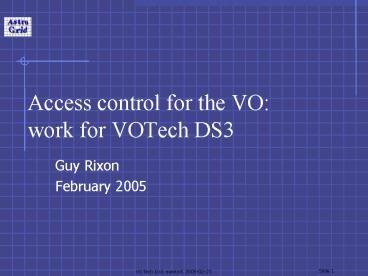Access control for the VO: work for VOTech DS3 - PowerPoint PPT Presentation
1 / 17
Title:
Access control for the VO: work for VOTech DS3
Description:
Which user sent this command? Which agent sent this command? Is that agent allowed to act for ... Service S trusts user U. U does not entirely trust agent A. ... – PowerPoint PPT presentation
Number of Views:35
Avg rating:3.0/5.0
Title: Access control for the VO: work for VOTech DS3
1
Access control for the VOwork for VOTech DS3
- Guy Rixon
- February 2005
2
This talk
- Security goals
- Challenges and techniques
- Where the VO is going
- Work for DS3
3
Requirements
- Computers not compromised by VO
- VO resources not damaged by attackers
- VO resources not damaged by users
- Private files stay private
- Resources rationed where necessary
- Access control does not impede users
- Access control does not prevent interoperation
4
Services not compromising the hosts
- Minimal privilege
- E.g. dont run as root
- Minimal 3rd-party software
- E.g. dont deploy httpd if not needed
- Chroot jail
- Keep up to date with patches
5
Ease-of-use constraint
- Access control invisible after session start
- gt single sign-on (SSO)
- gt delegation of access rights to agents
- Registration of users into system not onerous
- C.f. UK e-Science certification
- Ideally, users pre-registered by their employers
- gtregistration is distributed amongst
institutions, not centralized - gt idea of community as registration point
- Allow sharing of resources
- User-defined groups
6
Interoperability constraint
- Need standard systems
- Standard in Euro-VO
- Standard in IVO, via IVOA
- Not a separate system for each regional VO
- Only a small number of distinct protocols for
authentication, authorization. - E.g. one for SOAP, one for raw HTTP, but only one
for each.
7
Protecting/rationing resources
- Authorization
- Is user U allowed to do operation O?
- Static rights lists
- Dynamic tracking of quota
- Authentication
- Which user sent this command?
- Which agent sent this command?
- Is that agent allowed to act for the user?
- Is the message unaltered?
- Is the message a replay?
- Accounting
- Routine who used what? How much is left?
- Exceptional who was working when things went
wrong?
8
Delegation chain
User
User agent
Workflow agent/service broker
DSA/data processing
VOSpace
9
Identity delegation
- Service S trusts user U.
- U trusts agent A.
- U lets A authenticate as U.
- gt S trusts U as much as A.
- gt A can do anything U can to S.
- gt A could misuse Us privileges.
- gt U doesnt need to know which privileges are
required.
10
Privilege delegation
- Service S trusts user U.
- U does not entirely trust agent A.
- U gives A a ticket authorizing a specific action.
- Ticket is specific to A.
- A authenticates to S as itself.
- A gives S the ticket.
- gt S allows A only the actions in the ticket.
- gt A cant misuse Us privilege
- gt U needs to know what tickets are required
11
Delegation trust boundaries
All agents/services
Trust with ticket
Trust with ID
DSA/data proc
UA
SSO
Workflow
VOSpace
12
Bridging communities
IVOA
EuroVO
Web archives/ Digital libraries
HPC/grid
13
Emerging architecture registration
- Group users into natural communities
- E.g. University departments
- One registration point per community
- Registration done by Registration Authority
- RA local to community gt knows users
- RA uses local, passworded interface to register
- Users can be pre-registered by RA
- Registration -gt SSO password for each user
14
Emerging architecture SSO
- User signs on by giving SSO p/w to user agent
- UA forwards SSO p/w to community service
- Community checks p/w, issues credentials
- Key pair for digital signature
- Identity warrant tied to key pair (X.509?)
- Etc?
- Credentials sent using SAML
- UA retains, uses credentials during session
- Discard credentials at end of session.
15
Emerging architecture authentication
- Several different schemes
- Digital signature on message, unprotected
transport - Use for SOAP messages
- Digital signature of challenge phrase, then TLS
protection of message transport - GSI use for GridFTP and SRB
- Temporary passwords
- Established by the SSO system, passed in HTTP
cookies - Use for HTTP services, web sites and D-Space
(Shibboleth)
16
Emerging architecture authorization
- Policy
- may be held inside service it applies to
- may be held in community
- In each case, policy may be based on user groups
- Membership of groups always held in community
- gt authorization usually requires transfer of
data from community to service - Pull service contacts community at time of
authorization - Push authorization tickets sent with request
to service - User delegates identity -gt pull authorization
- User delegates specific rights -gt push
authorization - Use both modes in different parts of system
17
Prototyping work for DS-3
- Find WS-Security libraries for Axis SOAP
- Try Shibboleth for protecting web-sites
- Shibboleth gateway for getting into D-space
- Shibboleth as credential source for SOAP security
- GSI gateway for talking to GridFTP
- Language for authorization tickets (SAML based?)































